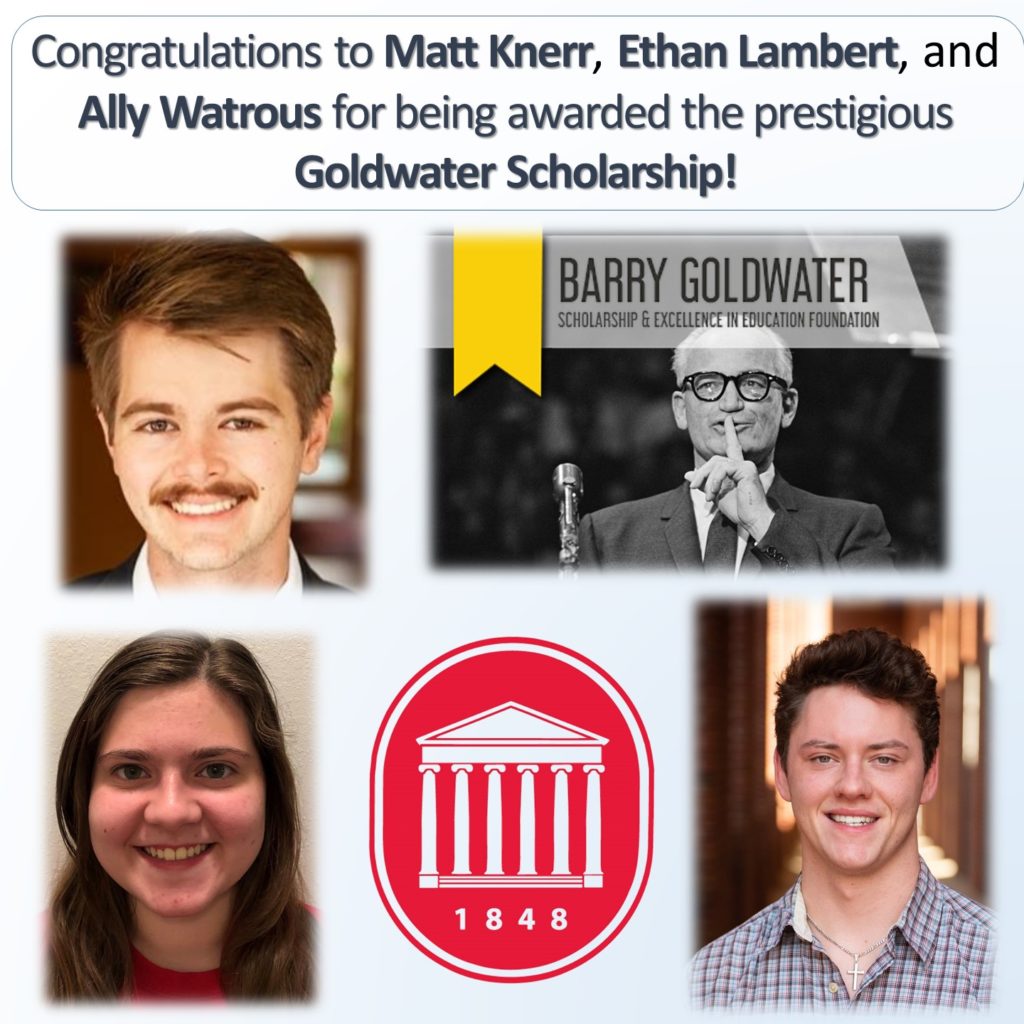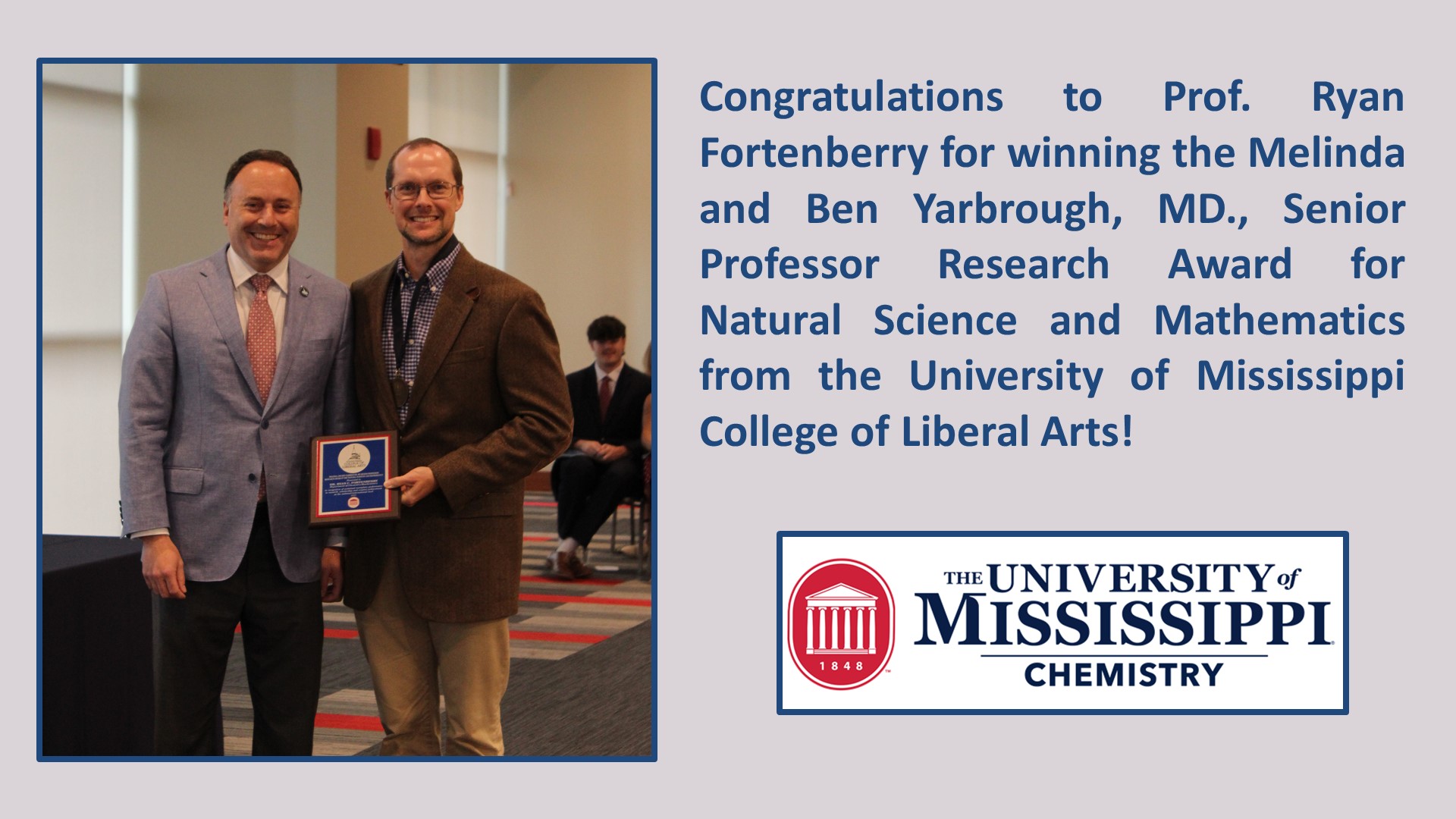
Archive for the ‘Chem News and Events’ Category
Profs. Tanner and Hammer Recognized at Research Banquet
A dozen outstanding faculty members at the University of Mississippi were recognized Tuesday (April 29) at the inaugural Chancellor’s Awards for Research and Creative Scholarship.
The event, held at The Inn at Ole Miss, recognized faculty whose work has elevated the university’s research and creative scholarship profile and contributed to its R1 designation, a classification for institutions with the highest levels of research activity.
“As you progress in your careers, I once again encourage you to keep nurturing the drive and the yearning that led you here,” Chancellor Glenn Boyce told the honorees. “You are and can be the most inspirational voices on this campus. Keep setting that bar high.
“We need you to continue to be the example not just for your students, but for our young researchers, too. Help them change the world.”

The Office of Technology Commercialization recognized Nathan Hammer, the Margaret McLean Coulter Professor of Chemistry and Biochemistry as a UM Inventor. Hammer represented a team that that earned a U.S. patent last year. Hammer’s team patented NIR-II dyes, compounds that can help researchers image biomolecules in deep tissue imaging. Hammer was awarded with a plaque with of the inventors’ names and the first page of the patent engraved on them.
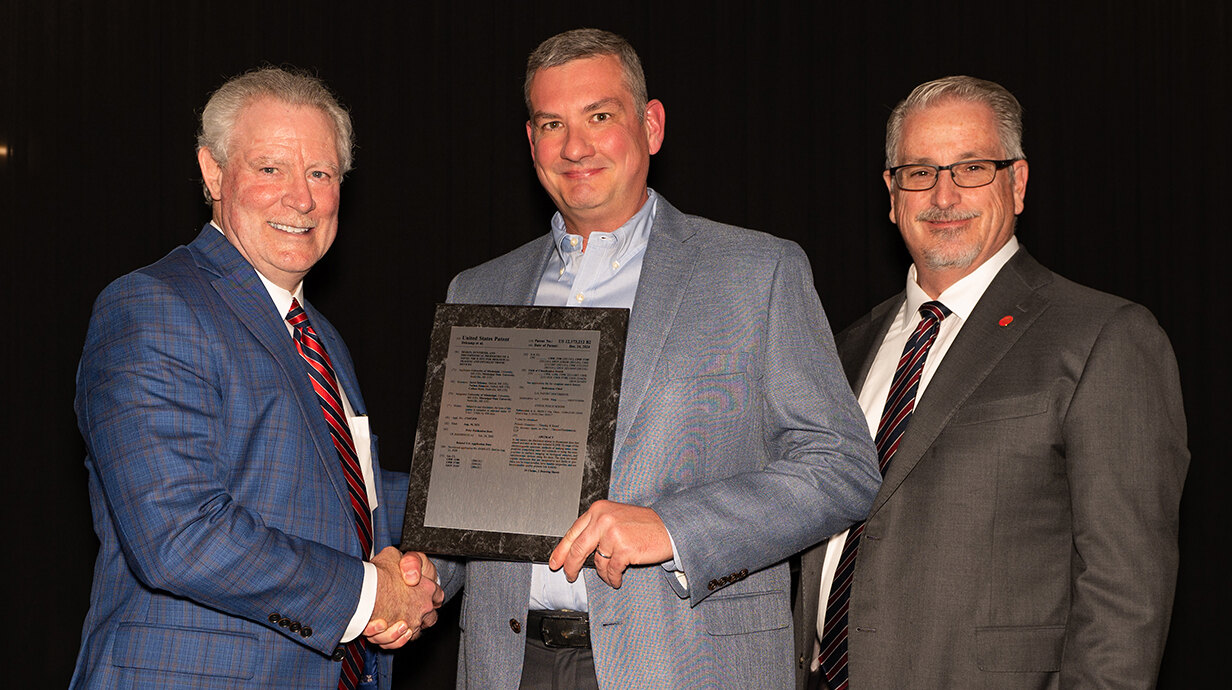
Chancellor Glenn Boyce (left) and John Higginbotham (right), vice chancellor for research and economic development, present Nathan Hammer with a UM Inventor award at the inaugural Chancellor’s Awards for Research and Creative Scholarship. Hammer, the Margaret McLean Coulter Professor of Chemistry and Biochemistry, represented a team of researchers who obtained a U.S. patent for technology they developed on campus. Photo by Bill Dabney

The inaugural Awards for Research and Creative Scholarship highlighted faculty members in multiple categories, including arts and humanities; social and behavioral sciences; and life science, physical science, math or engineering. Each recipient received a trophy and monetary award.
“While it’s easy to look back on a long career and see the impact a faculty member has made, it’s sometimes harder to see progress as it’s happening,” Provost Noel Wilkin said. “Each step from assistant to associate then full professor creates an arc of accomplishments that deserves to be recognized.
“The chancellor saw the need to highlight outstanding faculty throughout their careers, and so we created the Awards for Research and Creative Scholarship. For life science, physical science, math or engineering, the chancellor recognized Eden Tanner, assistant professor of chemistry and biochemistry. “Whether it’s through groundbreaking science, artistic insight or social impact, the faculty honored tonight are changing the face of this university,” Higginbotham said. “Their work doesn’t just add to academic knowledge; it builds a foundation for future discovery, collaboration and leadership on our campus.”

Chancellor Glenn Boyce (left) and John Higginbotham (right), vice chancellor for research and economic development, present Eden Tanner with a Chancellor’s Award for Research and Creative Scholarship. Tanner, assistant professor of chemistry and biochemistry, was honored in the life science, physical science, math or engineering division. Photo by Bill Dabney
Susan Pedigo Bids Farewell With Wisdom and Warmth

Mortar Board’s honored lecturer shares personal stories, scientific passion and life lessons.
Pedigo, a professor of chemistry and biochemistry, spoke Friday (May 2) before an intimate crowd of current students, former students and colleagues in the Overby Center auditorium. She shared lessons she learned from students as part of UM Tassels Chapter of Mortar Board.
“In the long run, life is not a multiple-choice test; it’s about actively engaging in the long term and not being afraid to be wrong,” Pedigo said.
The Last Lecture Series began at Ole Miss in 2013. It was inspired by the book “The Last Lecture” by Randy Pausch.

“The Last Lecture represents a special opportunity for Mortar Board to honor and celebrate a retiring member of the faculty, offering them an opportunity to share about their career or their final thoughts about the importance of higher education,” said Brent Marsh, assistant vice chancellor of student affairs and dean of students.
“In the early years, the chapter didn’t necessarily select a retiring faculty member to speak, so Dr. Pedigo is taking a victory lap as our only two-time lecturer.”
In her victory lap, Pedigo shared imprinting, her fascination with biochemistry as well as her mental and physical scrapbook of memories and proud professor moments of students.
Described as a humanist driven by curiosity about the connections found in life, Pedigo said she was destined to become a professor. It all started at a young age, when she accompanied her mother to classes at the University of Alabama.
“I was kindergarten-age and have clear memories of the library – how it echoed,” she said. “The people were so focused on what they were doing – I remember thinking that there was some kind of magic going on.
“And I just felt like I had to become a professor or an academic of some sort.”
The academic came out in her when she earned her doctorate in biochemistry from the University of Iowa after working as an analytical chemist in a medical college because “hearing those medical stories was so cool.”
Biochemistry blends biology and chemistry so that life can be thought about on a molecular basis. “The thing that’s cool is that trust, love and nurturing are all tied to genes or chemicals in your body, and biochemistry is leading to things like philosophy and chemistry,” she said.

She joined the Ole Miss faculty in 2000 as the first tenure-track woman in the chemistry department. The disadvantage to being the first woman was the isolation and the persistent feeling of “why did they hire me?'” she said.
“But the one thing that’s the value-added component of being the first woman in a tenure position was that it was like a magnet for students from underrepresented groups in STEM. I collected this diverse group of students in my lab that I got to work with.”
Pedigo has won awards for her research into how the structure of proteins influences their function in the body. But she maintains that her most important work has been influencing students.
She has enabled more than 130 students to perform research under her guidance, and she proudly shared photos of some 40 of them during the lecture.
“I think my students are the strongest students at the university – they are very accomplished scholars and bright – I have acknowledged this and their abilities,” she said. “Many will be future physicians, and it’s been such a privilege to teach these students.”
Beth Arantz, a senior biochemistry major from Sydney, Australia, called Pedigo a great mentor.
“She’s probably one of the most intelligent people I’ve ever met,” Arantz said. “She remains open-minded and even as a professor of how many years, she constantly wants to learn and pushed students too to remain open-minded.”

Pedigo has worn many hats throughout her tenure as a professor: professor, mother, colleague, wife and friend, noted Capri Lobotzke, a junior biomedical engineering major from Colorado Springs, Colorado.
“Balancing her many roles, Dr. P has always strived to be a thoughtful professor, sharing her love of biochemistry with her students, still making it home for dinner to be with her husband and kids,” Lobotzke said. “She values every relationship and longs to learn something new from every person she meets, working to see the world from their perspective.”
Pedigo shared that she was asked several years ago by a female student whether a woman could do her job and have a family. The professor responded by written correspondence late at night, after the dishes were washed and laundry folded:
“Yes, you could have it all – a career and a family – but you have to get used to letting some things go.”
As a biochemistry professor and researcher, Pedigo had job flexibility, intellectual challenge and talented students.
She told her audience that when we are young, life is simpler than it seems.
“The key is to work hard, enjoy what you do and to love as if there is no tomorrow,” she said. “Don’t worry, it’ll be OK.”
Top: Susan Pedigo, professor of biochemistry and chemistry, delivers the Mortar Board’s Last Lecture of the 2024-25 academic year. Pedigo is retiring after 25 years of teaching and research at Ole Miss. Photo by Srijita Chattopadhyay/Ole Miss Digital Imaging Services
Researchers Find Biochar Reduces Microplastic Pollution in Agricultural Runoff by More than 92%

Boluwatife Olubusoye, a doctoral student in chemistry, places bags of biochar, or specially heated biowaste, at the head of a runoff tunnel. Olubusoye and a team of Ole Miss and USDA researchers found that biochar can filter more than 92% of microplastics from runoff water. Submitted photo
Using treated plant waste as a filter reduced the presence of harmful microplastics in agricultural runoff by more than 92%, according to a new study authored by a University of Mississippi research team.
Microplastics – tiny plastic particles that are smaller than 5 millimeters – have been found in every ocean on earth, in food, water, and recently, in farmlands. An Ole Miss-led research group has published proof-of-concept data that shows biochar to be a cost friendly and effective method of filtering microplastics from overland water runoff.
Biochar is a type of charcoal made from plant material that has been heated or burned in an oxygen-limited environment.

Boluwatife Olubusoye, a doctoral student in chemistry, collects a sample of agricultural runoff water in the Mississippi Delta. Submitted photo
“Microplastics in the environment stem in part from the degradation of larger plastic by natural physical, chemical and biological processes,” said James Cizdziel, professor and interim chair of the Department of Chemistry and Biochemistry.
“They pose an enormous challenge as they are widespread, persistent and can accumulate in plants and wildlife, leading to detrimental effects on certain organisms and, potentially, on humans who consume them.”
Microplastics have been found in humans and the part of human brains responsible for smell. Though scientists don’t yet know the effects of microplastics on the human body, many studies show that the plastics negatively affect fish and animals that ingest them.
Microplastics in agriculture come from two primary sources, said Boluwatife Olubusoye, an Ole Miss doctoral student in chemistry and an author of the study. Sewage sludge from wastewater treatment plants, which is used as a fertilizer, and plastic mulch and row covers, which insulate plants and promote growth, both bring measurable amounts of microplastics to agricultural areas.
“When these plastic sheets break down in the field, they become very tiny and that’s how you get microplastics in the agricultural fields,” the Lagos, Nigeria, native said. “What happens is that when there is a heavy rainfall, there will be a wash of this agricultural field, which can lead to agricultural runoff.
“And this runoff can transport microplastics, and other pollutants, from the farm into aquatic environments – such as rivers, lakes and oceans – where microplastics can pose threats to organisms like oysters and small fishes.”
Many animals, including humans, feed on such organisms, where the microplastics could be passed on.
Olubusoye and collaborators from the U.S. Department of Agriculture’s Water Quality and Ecology Research Unit in Oxford traveled to a farm near Beasley Lake in the Mississippi Delta to collect agricultural runoff.

James Cizdziel
They tested the water for microplastics in Cizdziel’s microplastic research laboratory at Ole Miss, and passed the runoff through biochar to determine how effective it was at capturing the microplastics.
“We also observed that in addition to agricultural runoff, urban stormwater runoff is a prominent source of microplastics pollution,” Olubusoye said. “Our research is trying to reduce the influx of these contaminants from these runoff events into downstream water bodies.”
Using biochar reduced the amount of microplastics in samples of runoff by between 86.6% and 92.6%. Because of the success of the initial tests, the researchers are scaling up efforts to test biochar in the field.
The researchers will present their findings at three upcoming conferences, including:
- The University Council on Water Resources, National Institute of Water Resources and American Water Resources Association Conference
- The Mississippi Water Resources Conference
- The Society of Environmental Toxicology and Chemistry.

A microscopic look at biochar shows microplastic particles that were caught and removed from agricultural runoff in the Mississippi Delta. Submitted photo
“Our findings underscore the potential of biochar to be a cost-effective adsorbent for the removal of microplastics from runoff,” Cizdziel said. “As such, scaled-up field studies are underway and preliminary data show a marked decrease in microplastics, including tire wear particles, after the runoff passes through large filter socks filled with biochar.
“Our work could result in new agricultural and stormwater management practices to mitigate microplastic pollution stemming from farms and urban runoff in order to safeguard environmental and human health.”
This material is based on work supported by the National Science Foundation grant no. MRI-2116597 and the National Institutes of Health award no. P20GM103460.
OPEN POSITION: Assistant Professor of Chemistry (ANALYTICAL/PHYSICAL)
Position Description
The Department of Chemistry and Biochemistry at the University of Mississippi, located in Oxford, Mississippi, invites applications for a tenure track faculty position at the ASSISTANT PROFESSOR level in the area of ANALYTICAL or PHYSICAL CHEMISTRY to begin in August 2025. Click Here to apply.
Individuals with expertise in any area of analytical or physical chemistry, including experimental or computational/theoretical chemistry and those complementing active research programs in the Department (e.g. astrochemistry, forensic chemistry, nanomaterials, chemical physics, energy, and environmental chemistry) are strongly encouraged to apply.
The Department has 19 tenured and tenure-track faculty, 9 teaching faculty, and a vibrant graduate Ph.D. program. A new $175M STEM education facility on campus has just opened that will foster interdisciplinary opportunities to fulfill our commitment to inclusive excellence in chemical education. Details of this facility can be found on the departmental website (chemistry.olemiss.edu).
The successful candidate is expected to establish a nationally recognized, externally funded research program; provide mentorship for graduate and undergraduate researchers; demonstrate excellence in teaching; and perform service to the department, college, university, and community (visitoxfordms.com)
Position Details
Appointment: 9 Month
Assignment Type: Tenure Track
Minimum Qualifications
Applicants must have a Ph.D. and relevant experience beyond the Ph.D. in analytical or physical chemistry (broadly defined) or a closely related field.
Application Procedures
Review of applications will begin October 15th, 2024 and continue until an adequate applicant pool is established. Applications must be submitted online (careers.olemiss.edu) and should include a cover letter, a current CV, research plans, and a teaching philosophy statement.
Because the University of Mississippi and the Department of Chemistry and Biochemistry are committed to building an inclusive and diverse university community, applicants should specify within their application how their teaching, scholarship, and service will contribute to a diverse and inclusive community. During the online application process, applicants will be prompted to provide the names and email addresses of three professional references that will provide letters of recommendation.
About the University of MS & Oxford, MS
Founded in 1848, the University of Mississippi (UM), affectionately known to alumni, students and friends as Ole Miss, is Mississippi’s flagship university. Included in the elite group of R-1: Doctoral Universities – Highest Research Activity by the Carnegie Classification, it has a long history of producing leaders in public service, academics and business. The University of Mississippi, consistently named by The Chronicle of Higher Education as a “Great College to Work For,” is located in Oxford, MS, which is ranked one of the “Top 10 Best College Towns.” With more than 24,000 students, UM is the state’s largest university and is ranked among the nation’s fastest-growing institutions. The University of Mississippi, which has aggressively implemented many health and wellness initiatives for its more than 2,900 employees, has consistently been named one of Mississippi’s Healthiest Workplaces.
Touted as the “Cultural Mecca of the South”, creativity abounds in Oxford as musicians, artists and writers alike find inspiration in Oxford’s rich history, small town charm and creative community. Oxford is a one-hour drive south of Memphis, TN and is known as the home of Nobel Prize winning author William Faulkner. Over the years Oxford has also been known for offering exceptional culinary experiences and as the home of the University of Mississippi and the Ole Miss Rebels, there is always something here to immerse yourself in. Oxford has also been featured as a literary and arts destination in such publications as The New York Times, Southern Living, Condé Nast Traveler, and GQ. Among other cultural activities, annual events include the Oxford Film Festival, a thriving local music scene, and the Ford Center Performing Arts Series. Oxford is a vibrant university town, filled with unique shops and galleries, eclectic restaurants and clubs, historic landmarks, and comfortable inns.
Background Check Statement
The University of Mississippi is committed to providing a safe campus community. UM conducts background investigations for applicants being considered for employment. Background investigations include a criminal history record check, and when appropriate, a financial (credit) report or driving history check.
EEO Statement
Department Welcomes Instructor Amy Lynn Rosen
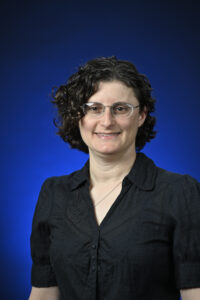
Amy Lynn Rosen, Instructor
Amy Lynn Rosen will join the University of Mississippi Department of Chemistry & Biochemistry as an Instructor and the Associate Coordinator of Undergraduate Labs on August 1st. Ms. Rosen received her Bachelor of Science from the University of California, Berkeley, in 2001, a Masters of Science from Indiana University in 2003, and a Masters in Arts in Science Education from Columbia University Teachers College in 2004. She was a US Presidential Scholar Distinguished Teacher in 2021 and Outstanding Teacher of the Year for the Lafayette County Soil & Water Conservation District in 2023.
Her professional interests lie in chemistry education, development of curricular materials, inclusive practices in undergraduate education, training secondary science educators, and community outreach.
Chemistry Department Remembers Beloved Professor Kwang Yun
Kwang S. Yun (1929-2022), an award-winning chemistry professor who taught at UM for 30 years, was known for his creative teaching methods and dedication to students. He received the Cora Lee Graham Outstanding Teacher of Freshmen award from the College of Liberal Arts, the 1981 Outstanding Teacher of the Year Award for the University (now known as the Elsie M. Hood Award), and the Phi Eta Sigma Honor Society’s Outstanding Teacher Award. Prof. Kwang Yun joined the Department of Chemistry in 1968 and taught general chemistry, physical chemistry, and graduate courses in quantum chemistry and statistical thermodynamics for 31 years. He was loved by his students and retired in June 1998, but still participated in physical chemistry divisional activities up until 2020.

Prof. Emeritus Kwang S. Yun (1929-2022)
Originally from Seoul, Korea, Yun received a B.A. in chemistry from Seoul National University before serving in the Republic of Korea Army from 1953 to 1955 and earning a Ph.D. in chemistry from the University of Cincinnati in 1960. “I had the great pleasure of teaching the freshman chemistry course,” Yun said. “Students in this class were mostly pre-med, pre-pharmacy or engineering students who were well motivated and eager to learn new and advanced concepts in chemistry. For more than 30 years of teaching this course, I have nothing but good memories.”

Prof. Emeritus Kwang S. Yun at a University of Mississippi commencement
Yun had several memorable moments from the classroom. “I gave weekly live demonstrations related to the subjects of the week,” he said. “Students enjoyed the demonstrations, but I had a few embarrassing moments with burning hair, burning neckties, falling from ladders and so on.”
The effectiveness of Yun’s teaching is evident. “More than 6,000 students passed through my freshman classes during my years of teaching, which generated many well-known doctors and pharmacists,” Yun said a few years ago. “I see them often.”
“When I was an undergraduate chemistry student, he was the first chemistry professor I took that made sense,” Associate Dean Emeritus for Research & Graduate Education and Distinguished Professor Emeritus Charles Hussey said. “He knew how to teach. When I was in his class, I was always very comfortable — he explained concepts like no one else.”
It was indeed a high priority for Yun to successfully convey the material that he was teaching. “I held weekly help sessions and enjoyed the recitations because it was a ‘free question-and-answer period’ where students felt comfortable asking any questions,” he said. “Because my main interest in teaching was to provide students knowledge and excitement in science, I always approached students not in terms of my level of understanding but at the student’s level. I used to say to myself, ‘If a student does not comprehend an idea, it is my fault and not the student’s.’” Prof. Randy Wadkins had Yun as a teacher while he was at Ole Miss as an undergraduate and a graduate student. Wadkins recently indicated that “What might not be appreciated is that Dr. Yun also taught math. I kept all the notes from his class all these years.” It is evident Dr. Yun holds a special place in the hearts of his former students and was well respected by his colleagues. He taught chemistry and helped many students prepare to pursue their careers in medicine, pharmacy, science, and other fields. He was a favorite teacher because he really cared about his students and was always willing to help them succeed.
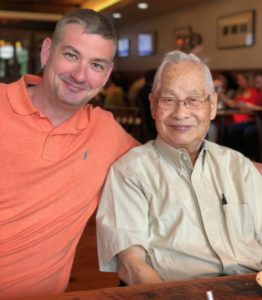
Profs. Nathan Hammer and Kwang Yun in 2018
Prof. Dan Mattern was a colleague of Yun for a number of years in the department. Mattern recently said “I too am saddened by the loss of Kwang, who was always upbeat, enthusiastic, and smiling. He was also very precise in his teaching of chemistry, and his classes appreciated his careful explanations, and his consideration for his students. After he retired, he took up oil painting, with landscapes and scenes around Oxford–quite a switch from physical chemistry. A couple of years ago, he told me about his schooling under the Japanese occupation of Korea. All the instruction was in Japanese, and the teachers were rigid, but not mean. One day he went to school, and the entire teaching staff was gone. Japan had withdrawn from Korea, and that included leaving the schools, overnight. I’m always impressed with people who have to switch languages when they immigrate. Kwang had to switch from Korean to Japanese, and then to English. We will miss him.”
Long after his official retirement from the University in 1998, Yun continued to come to campus and check out books from the library to read. Prof. Nathan Hammer shared that Dr. Yun also continued to perform spectroscopy experiments alongside undergraduate and graduate students in his lab up until just a few years ago. Hammer said “Prof. Yun loved science and being in the lab. He gave lectures to our Summer Research Experience for Undergraduates (REU) program on classical physical chemistry concepts and really enjoyed attending physical chemistry division social event. The students loved learning from his lifelong experiences and always looked forward to him bringing watermelons to our end of summer REU party.”
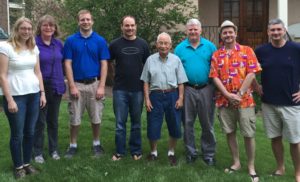
REU Faculty in Summer 2016 with Prof. Yun in the center.
Dr. Yun was also interviewed in 2019 by Bonnie Brown for HottyToddy.com and this interview is below.
Brown: Where did you grow up? Please talk about your childhood, family, and siblings.
Yun: I was born in Seoul, South Korea in 1929. I remember that I lived with my grandparents and my parents with five sisters. My sisters and I all emigrated to the United States. Two sisters are deceased. One lives near Chicago, one in Long Island, and the other in Detroit. My wife and I have one daughter who lives in Portland, Oregon.
Brown: Where did you go to school?
Yun: In 1936, I entered an elementary school near my home in Seoul several blocks away. I enrolled in a middle school (7th to 10th grades) which was about two miles away from my home. Those are from 1942 to 1946. Since Korea was a colony under the Japanese, we have to take the Japanese educational system; everything was taught in Japanese but I learned Korean from my parents.

Dr. Yun’s Family – April 1936 with his sisters, his parents (back row), Grandparents (middle row); Dr. Yun is pictured standing in the center.
In 1946, after the end of World War II, we became independent from Japan. I entered a preparatory school which was a part of the Seoul National University. This prep school was similar to a German gymnasium system (a type of school with a strong emphasis on academic learning) enforcing math and foreign languages. I had two years of high school just after the Japanese left Korea.
I advanced to an undergraduate program as a chemistry major and finished my undergraduate degree in 1952 which was during the Korean conflict. I was drafted and served two and a half years in the South Korean Army and was discharged in 1955.
I was admitted to the University of Cincinnati in 1956 and completed a Ph.D. degree in 1961.
Brown: How did you choose the University of Cincinnati?
Yun: From 1946 until 1952, Korea depended on U.S. aid in the national public schools. Much of that aid was in the form of army supplies—educational manuals used in the military. My freshmen through senior high school years, we studied English text. I didn’t know anything about the various colleges. But in my sophomore year, I took organic chemistry and the textbook author was from the University of Cincinnati, so I thought that would be a good place to study.
Brown: What subjects were hardest for you in school?

Mrs. Yun with Dr. Yun on the occasion of his retirement in 1998.
Yun: The difficult subjects for me were physics and mathematics.
Brown: Who influenced your career choice?
Yun: My father, who suggested that I should study science but not law. My father was a merchant who had two years of college. I was 27 when I started my graduate work at the University of Cincinnati. My wife went to LSU but later attended Ohio State.
Brown: Tell us how/when your Ole Miss “story” began? Who hired you? How long did you work at Ole Miss?
Yun: I had two post-doctoral positions—one at the University of Maryland and the second one at the Research Council Lab in Canada. Since the post-doctoral positions were not renewable, I began to look for a teaching position. I had several offers, but the offer from Ole Miss was the best. Dr. Robert B. Scott, Jr, Chair of the Chemistry Department hired me. Dr. Andrew Stefani recommended me. Dr. Scott was my Department Chair but he also became my friend. He and his wife, Russell, helped me and my wife a lot, teaching us about Southern culture. I joined the Department of Chemistry in 1968 and taught general chemistry, physical chemistry, and graduate courses in quantum chemistry and statistical thermodynamics for 31 years. I retired in June 1998.
Brown: What did you know about Ole Miss before you accepted a position here?
Yun: The only information I had was the information provided by the American Chemical Society. So I didn’t know much about the university before I arrived. When I came to Oxford, there were about 5,000 students. My wife and I lived in Northgate Apartments on campus (faculty and staff housing). I remember the first person who helped me was Mrs. Margaret Fields. She was very kind and very helpful.

L-R, Mrs. Yun, Dr. Yun, Connie Flake (Oxford artist) and her husband, Tim Flake.
Brown: Describe your most memorable days at work.
Yun: Teaching a large class of freshmen, fresh from their high school was challenging. That was some experience! For the first two years, I was assigned smaller classes because I was less experienced. However, after that I got the large freshmen classes.
Brown: What do you consider to be the highlight of your career?
Yun: In 1981, I received the Elsie M. Hood Outstanding Teacher Award. I also received the Cora Lee Graham Outstanding Teacher of Freshmen award from the College of Liberal Arts and the Phi Eta Sigma Honor Society’s Outstanding Teacher Award.
Brown: What accomplishment are you most proud of?
Yun: Teaching! There have been more than 6,000 students who went through my classes during my years of teaching, which generated many well-known doctors and pharmacists.
Brown: If there was something in your past you were able to go back and do differently, what would that be?
Yun: Be nice to under-prepared students. I didn’t mind repeating answers to questions. Repetition in the explanation is a virtue. I was willing to repeat it until the students understood the concept.
Brown: What is the best advice you ever received?

Dr. & Mrs. Yun pictured with one of his oil paintings. He has sold over 60 paintings.
Yun: Be patient and don’t jump to conclusions.
Brown: If you could have an all-expenses paid trip to see any famous world monument, which monument would you choose?
Yun: I’d travel to the Canadian Rockies. It’s so beautiful there! I lived in Canada and Boulder, Colorado. I loved visiting Estes Park and other sites each weekend.
Brown: What do you do to improve your mood when you are in a bad mood?
Yun: Listen to classical music.
Brown: Tell us something about yourself that not many people may know.
Yun: I used to do oil painting, landscapes. I took lessons from Oxford artist Connie Flake around 1985. I also enjoyed getting to know Clarksdale native Jason Bouldin, son of portrait artist Marshall Bouldin. Jason was a freshman in my chemistry class and came to me to tell me at the end of his freshman year that he was going to Harvard to major in art history. Jason has followed in his father’s footsteps and has become a noted artist in his own right. I no longer paint but I enjoyed it very much.
Brown: What gives you great joy?
Yun: Reading and listening to music. I like reading old classics. I like German novels of the 18th and 19th centuries. I like reading about human history, the creation of the university, etc. And I love listening to classical music.
Three Chemistry Majors Receive Prestigious Goldwater Scholarship!
For the first time at the University of Mississippi, three students have been awarded Goldwater Scholarships in a single year.
Ethan Lambert, of Corinth; Reinhard “Matt” Knerr, of Paducah, Kentucky; and Alexandria “Ally” Watrous, of Lexington, Kentucky, all members of the Sally McDonnell Barksdale Honors College, have become the university’s 19th, 20th and 21st winners.
The Goldwater is one of the oldest and most prestigious national scholarships in science, technology, engineering and mathematics fields. It supports exceptional sophomores and juniors who show promise in becoming the next generation of research leaders in these fields.
This year, the Barry Goldwater Scholarship and Excellence in Education Foundation awarded 417 scholarships from a pool of 1,242 outstanding undergraduates nominated by 433 institutions.
“Ethan, Matt and Ally have all presented an incredible commitment to a career in research, and a genuine display of intellectual curiosity,” said Vivian Ibrahim, director of the UM Office of National Scholarship Advisement. “This is the first time UM has had three Goldwater scholars. We couldn’t be more excited for them.”
In recent years, the office has had steady success in recruiting competitive students for the Goldwater, Ibrahim said.
Knerr, Lambert and Watrous follow in the footsteps of Ole Miss Goldwater scholars Ivy Li and Austin Wallace in 2021, William Meador and Jax Dallas in 2020, and Addison Roush in 2019.

Ethan Lambert, a junior from Corinth, is studying light-induced electron transfers to help improve solar energy technologies. He has been awarded a 2022 Goldwater Scholarship to support his studies and research. Photo by Thomas Graning/Ole Miss Digital Imaging Services
An Annexstad scholar, Lambert is set to graduate in 2023 with a bachelor’s degree in chemistry with an emphasis in chemical physics and a minor in mathematics.
“I am thrilled to be named a Goldwater Scholar but this accomplishment would not have been possible without the incredible people around me in the lab,” he said. “They taught me new techniques, proofread and answered my questions at 2 a.m. when I couldn’t sleep.
“I would be a fraction of the person I am without them around me.”
Lambert hopes to apply for a graduate research fellowship from the National Science Foundation next year to fund a doctorate in chemistry with a focus on studying how to use light to induce electron transfers between small molecules. This work has potential real-world applications in solar energy conversion.
Already first author on three published research papers and co-author of a book, Lambert has been working with Nathan Hammer, UM professor of chemistry and biochemistry.
“It has been a joy mentoring Ethan in the lab,” Hammer said. “He truly has the love for science and the aptitude for research. I expect great things from him for the remainder of his time with us at UM and beyond.”
Knerr is a Stamps scholar who is pursuing a degree in biochemistry, with minors in neuroscience, biological sciences, environmental studies and psychology.
“I am fascinated by aging,” he said. “My time abroad – in Spain, Costa Rica and the Netherlands – has really shed light on different ways to approach how we age.
“In the future, I want to be able to look at aging from a scientific angle as well as a moral and humanistic one.”
Knerr has four published articles and has worked Joshua Bloomekatz, an assistant professor of biology.
“Matt is a dynamic student with a passion for research, who shows great promise as a physician scientist,” Bloomekatz said.
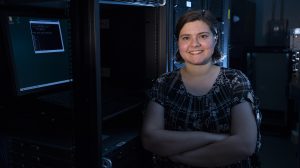
Ally Watrous, a sophomore from Lexington, Kentucky, already has published three peer-reviewed papers in computational chemistry. Her Goldwater Scholarship will provide funding for her junior and senior years at the university. Photo by Thomas Graning/Ole Miss Digital Imaging Services
Watrous is the only Ole Miss sophomore to be awarded a Goldwater, which will provide funding for her junior and senior years at the university. She is pursuing bachelor’s degrees in chemistry with a chemical physics emphasis, in physics and in German with minors in French and mathematics.
In the long term, Watrous is interested in collaborating internationally while conducting research in computational chemistry.
“The whole national scholarship and Goldwater process reaffirmed that grad school is something I want to do and can achieve,” she said.
Watrous has three peer-reviewed papers and one cover article to date as part of the UM Computational Astrochemistry Group, headed by Ryan Fortenberry, associate professor of chemistry and biochemistry.
“Ally is an absolute joy to have in our group, and I count myself lucky to be on her team through her education,” Fortenberry said. “Most often, about the time that students get trained, they leave. However, she’ll be around for a few more years, and I look forward to continuing my collaboration with her.”
For more information on the Goldwater Scholarships and how to apply for them, contact the Office of National Scholarship Advisement at onsa@olemiss.edu.
Prof. Tanner’s research could improve treatment options for cancer, arthritis

University of Mississippi chemistry professor Eden Tanner (front left) and her team of researchers are a diverse group, including one postdoctoral scholar, six graduate students and 18 undergraduates, who have majors ranging from chemistry and pharmacy to engineering.
A University of Mississippi Chemistry professor and her team of researchers are working on new ways to use red blood cells and platelets to transport chemotherapies and other medicines to specific areas of the body, which could greatly reduce patients’ side effects.
Eden Tanner, UM assistant professor of chemistry and biochemistry, has been awarded a Pharmaceutical Research and Manufacturers of America’s Research Starter Grant in Drug Delivery for $100,000 to help fund the work. The grant, which is given to one winner annually, is designed for tenure-track faculty who are in the earliest stages of their careers to advance their research in drug delivery.
Tanner’s research interests focus on solving biomedical and bioengineering problems using physical chemistry and, particularly, ionic liquids and nanomaterials. She is working to figure out ways to use ionic liquids and nanomaterials to bond to the blood components and send medicines to specific areas.
“We are really excited about the potential that this technology offers,” Tanner said. “Currently, if you get lung cancer and surgery is not an option, basically you just get bathed in chemotherapy.
“It makes people very ill. It is not a very positive experience.”
The lab in Coulter Hall where she works contains vials of ionic liquids in varying viscosities, some of them looking like honey or maple syrup. Researchers are using different ones to determine which work best for different types of drugs.
She explains the concept of cellular hitchhiking using the example of someone being treated for lung cancer.
“If we could instead just target the lung, for instance, and not have it go everywhere, this means the side effect profile is much less severe and people aren’t as sick,” Tanner said. “Our technology could be used to hitch a ride on red blood cells, which then deliver our cargo to the lungs, as opposed to everywhere else in the body.”
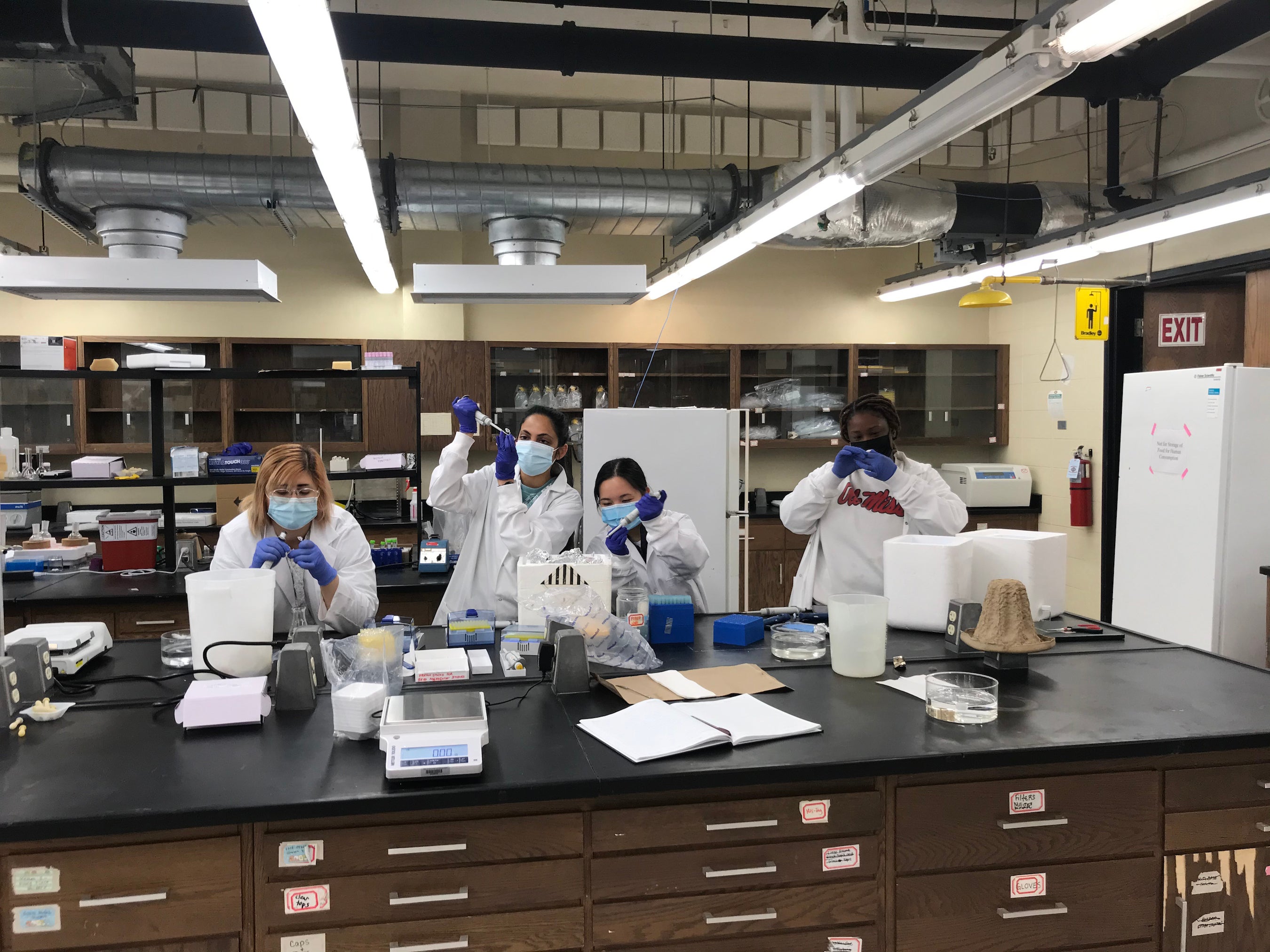
Student researchers work in Eden Tanner’s lab in Coulter Hall. Tanner and her team are studying new ways to use red blood cells and platelets to transport chemotherapies and other medicines to specific areas of the body.
Tanner holds a bachelor’s degree in advanced science from the University of South Wales in Australia and a doctorate in physical and theoretical chemistry from the University of Oxford in England, where she was a postdoctoral fellow. She also served as a postdoctoral fellow at Harvard University.
Tanner said she will use the award to continue training the next generation of drug delivery scientists. The funding will help procure technologies for the experiments and to hire assistants for the work.
She is pleased with not only the strength of the group assembled, but also that they come from many different backgrounds. All bring different experiences, perspectives and special skills to the table, she said. Among them are one postdoctoral scholar, six Ole Miss graduate students and 18 undergraduates, who have majors ranging from chemistry and pharmacy to engineering.
Some 65% of the group are women or nonbinary people, and 40% are people of color, Tanner said.
“I have a large team of excellent students,” Tanner said. “It is a very collaborative group effort. This is not a ‘lone genius’ situation.
“We bring people together from chemistry and pharmacy and other areas because we need their expertise to help us advance this along.”
Karen Wong, a senior biochemistry and Chinese major from Gulfport, said her work focuses on targeting platelets within the blood. Working on the project has taught her the importance of such research.
It’s an exciting process, too, she said.
“Engaging in research has allowed me to gain an understanding of how important it is to the medical world because there are so many limitations and risks associated with medical procedures as well as drugs,” Wong said.
“In addition, it is a very meticulous and slow process to work toward advancing science, but one must be patient and never give up on it because you never know when you’ll have a scientific breakthrough!”
She’s also learning the value of teamwork in the lab.
“Each experiment requires a lot of preparation, and I learned the importance of teamwork because it makes carrying out large experiments more efficient because each one of us was responsible for synthesizing specific nanoparticles, splitting the tasks, and putting our work together, in the end, made everything go much smoother,” Wong said.
Joh’nis Randall, a junior pharmaceutical sciences major from Jackson, said the experience has been “nothing short of amazing.” The work has taught her much more than just the necessary parts she needed to learn.
Randall said she has grown during the process and appreciates Tanner and the rest of the team for pushing her to be her best.
“From the early mornings and late nights in the lab, preparing for the day of the bloodwork was always a tedious task,” she said. “Doing this project has gotten me out of my shell and has expanded my knowledge on different aspects of physical chemistry.
Randall wants to make a difference.
“I hope that we all make a breakthrough in scientific discovery that would one day change how medicine works,” Randall said.
The way the lab is structured creates many chances for collaboration, a skill important in any career, said Meghan Gorniak, a senior chemistry major from Glen Carbon, Illinois.
“This lab has pushed me to think critically and to understand the application of so many scientific topics,” Gorniak said. “I hope that my work on white blood cells can help further medical science discoveries.
“I cannot thank Dr. Tanner enough for being my mentor and teaching me how cool research can be.”
UM professor’s research could improve treatment options for cancer, arthritis

